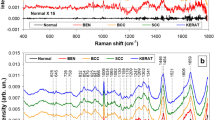Abstract
Paraconsistent logic (PL) is a type of non-classical logic that accepts contradiction as a fundamental concept and has produced valuable results in the analysis of uncertainties. In this work, algorithms based on a type of PL—paraconsistent annotated logic of two values (PAL2v)—are interconnected into a network of paraconsistent analysis (PANnet). PANnet was applied to a dataset comprising 146 Raman spectra of skin tissue biopsy fragments of which 30 spectra were determined to represent normal skin tissue (N), 96 were determined to represent tissue with basal cell carcinoma, and 19 were determined to be tissue with melanoma (MEL). In this database, paraconsistent analysis was able to correctly discriminate 136 out of a total of 145 fragments, obtaining a 93.793 % correct diagnostic accuracy. The application of PAL2v in the analysis of Raman spectroscopy signals produces better discrimination of cells than conventional statistical processes and presents a good graphical overview through its associated lattice structure. The technique of PAL2v-based data processing can be fundamental in the development of a computational tool dedicated to support the diagnosis of skin cancer using Raman spectroscopy.









Similar content being viewed by others
References
Abe JM, Ortega NRS, Mario MC, Del Santo Jr M (2005) Paraconsistent artificial neural network: an application in cephalometric analysis. knowledge-based intelligent information and engineering systems. Lect Notes Comput Sci 3682:716–723
American Cancer Society (2012) Cancer facts & figures 2012. American Cancer Society, Atlanta
Bodanese B, Silveira L Jr, Albertini R, Zaˆngaro RA, Pacheco MTT (2010) Differentiating normal and basal cell carcinoma human skin tissues in vitro using dispersive Raman spectroscopy: a comparison between Principal Components Analysis and simplified biochemical models. Photomed. Laser Surg. 28:S119–S127
Da Costa NCA (1974) On the theory of inconsistent formal systems. Notre Dame J Form Log 15(4):497–510. doi:10.1305/ndjfl/1093891487
Da Costa NCA, Marconi D (1989) An overview of paraconsistent logic in the 80’s. J Non-Class Log 6(1):5–31
Da Silva Filho J I (2011) Algorithms based on paraconsistent annotated logic for applications in expert systems. In: Segura JM, Reiter AC (eds) Expert system software: engineering, advantages and applications. Nova Science Publishers, Hauppauge. ISBN 978-1-61209-114-3
Da Silva Filho JI, Lambert-Torres G, Abe JM (2010) Uncertainty treatment using paraconsistent logic—introducing paraconsistent artificial neural networks. ISBN 978-1-60750-557-0 (print), p 320
Da Silva Filho J I, Holms GATA, Hurtado GV, Garcia DV (2009) Analysis and diagnosis of cardiovascular diseases through the paraconsistent annotated logic. In: Nakamatsu K et al (eds) New advances in intelligent decision technologies. Springer, Berlin/Heidelberg, pp 295–303
Da Silva Filho J I et al (2011) Paraconsistent algorithm extractor of contradiction effects—Paraextrctr. J Softw Eng Appl 4(1):579–584
Ferraro JR, Nakamoto K (1994) Introductory Raman spectroscopy. Academic Press Inc, EUA
Gniadecka M, Philipsen PA, Sigurdsson S et al (2004) Melanoma diagnosis by Raman spectroscopy and neural networks: structure alterations in proteins and lipids in intact cancer tissue. J Invest Dermatol 122:443–449
Kendall C et al (2011) Exploiting the diagnostic potential of biomolecular fingerprinting with vibrational spectroscopy. Faraday Discuss 149:279–290
Lieber CA, Majumder SK, Ellis DL, Billheimer DD, Mahadevan-Jansen A (2008) In-vivo nonmelanoma skin cancer diagnosis using Raman microspectroscopy. Lasers Surg Med 40:461–467
Lorincz A et al (2004) Raman spectroscopy for neoplasic tissue diferentiation: a pilot study. J Pediatr Surg 39(6):953–956
Magee ND, Beattie JR, Carland C et al (2010) Raman microscopy in the diagnosis and prognosis of surgically resected nonsmall cell lung cancer. J Biomed Opt 15:026015
Nakazawa K, Kalassy M, Sahuc F, Collombel C, Damour Dr O (1998) Pigmented human skin equivalent—as a model of the mechanisms of control of cell-cell and cell-matrix interactions. Med Biol Eng Compu 36(6):813–820
Nyström J, Lindholm-Sethson B, Stenberg L, Ollmar S, Eriksson JW, Geladi P (2003) Combined near-infrared spectroscopy and multifrequency bio-impedance investigation of skin alterations in diabetes patients based on multivariate analyses. Med Biol Eng Comput 41(3):324–329
Oshiyama NF, Bassani RA, D’Ottaviano IML, Bassani JWM (2012) Medical equipment classification: method and decision-making support based on paraconsistent annotated logic. Med Biol Eng Comput 50(4):395–402
Silveira L Jr et al (2012) Discriminating model for diagnosis of basal cell carcinoma and melanoma in vitro based on the Raman spectra of selected biochemical. J Biomed Opt 17(7):077003
Stone N et al (2007) The use of Raman spectroscopy to provide an estimation of the gross biochemistry associated with urological pathologies. Anal Bioanal Chem 387(5):1657–1668
World Health Organization (WHO) (2009) Ultraviolet radiation: global solar UV index [Fact Sheet No. 271]. World Health Organization, Geneva
Author information
Authors and Affiliations
Corresponding author
Rights and permissions
About this article
Cite this article
Da Silva Filho, J.I., Vander Nunes, C., Garcia, D.V. et al. Paraconsistent analysis network applied in the treatment of Raman spectroscopy data to support medical diagnosis of skin cancer. Med Biol Eng Comput 54, 1453–1467 (2016). https://doi.org/10.1007/s11517-016-1471-3
Received:
Accepted:
Published:
Issue Date:
DOI: https://doi.org/10.1007/s11517-016-1471-3




